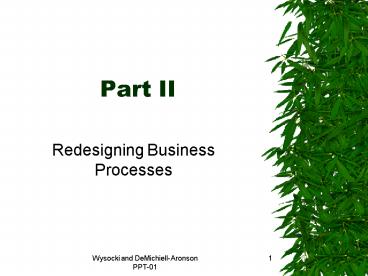Redesigning Business Processes - PowerPoint PPT Presentation
1 / 43
Title:
Redesigning Business Processes
Description:
Wysocki and DeMichiell-Aronson PPT-01. 1. Part II. Redesigning ... Desktop publishing. Imaging and document management. Multimedia. THE WEB. Integration options ... – PowerPoint PPT presentation
Number of Views:40
Avg rating:3.0/5.0
Title: Redesigning Business Processes
1
Part II
- Redesigning Business Processes
2
Part II
- Redesigning Business Processes
- Change!
3
7. Emerging Process View of Organizations
4
Business Process
- The things we do
- Any sequence of activities that consumes
resources and adds value to a product or service
5
The Definition of a Business as a Set of Business
Processes(Exhibit 7-1, p. 150)
6
Visualization of Core Process and Support
Processes(Exhibit 7-2, p. 151)
7
Matrix View of Business(Exhibit 7-3, p. 151)
8
Bounding the Business Process
- By design
- Also IS are bounded by design
9
Components
- Personnel
- Technology
- Process
10
Business Process Categories
- See Exhibit 7-5 for a list in New Product
Development and Support - See Exhibit 7-6 for Cycle Time Reduction through
Concurrent Engineering
11
New Product Development and Support(Exhibit 7-5,
p. 154)
12
Cycle Time Reduction through Concurrent
Engineering(Exhibit 7-6, p. 155)
13
Role Perspectives
- External and internal views
- Process owners and scope of authority
- The Quality Imperative
14
Lessons Learned
- Reengineering is tough and and unique
- Leadership is critical
- Employee involvement is critical
15
Quality Function Deployment Model
- Hmmm Exhibit 7-9. Skip, but
- Includes an Information Economic (Balanced)
Scorecard
16
(No Transcript)
17
(No Transcript)
18
(No Transcript)
19
(No Transcript)
20
(No Transcript)
21
(No Transcript)
22
(No Transcript)
23
End Chapter 07
- Chapter 08 starts on next page
24
8. Business Process Redesign
25
Downsizing and Rightsizing Repositioning Workers
- BPR NotDownsizing, but often used for it
26
Business Process Redesign Hierarchy(Exhibit 8-1,
p. 180)
27
The Role of the IEMgmt Team in BPR
- IT is an enabler of BPR
- Leadership role
28
BPR
- Glass 50 water
- Changing a jet engine in flight
- Fails around 80 of the time
- Why?
29
Why BPR Fails
- Executives use it for downsizing
- Executives dont really understand it-or the
required commitment for success - Executives dont really support it to get the buy
in of employees and managers - It is thrown at the company
- Outside consultants recommend and run it
- See Hammer and Champy
30
Project Management
- Change management-introduction of a new or
modified IS - Requires (people) skills that many technologists
must develop - Project management life cycle
- Project scope project scope creep
31
End Chapter 08
- Chapter 09 starts on next page
32
9. Human Resource Development
- IS staff are dispersed throughout the
organization - How to retain IS identity?
33
Learning Styles Inventory
- Related to Personality/Temperament Profiles
- We did True Colors
- People learn differently Exhibit 9-5
34
The Four Basic Learning Styles(Exhibit 9-5, p.
216)
35
End Chapter 09
- Chapter 10 starts on next page
36
10. The Service Role of Information Technology
- Utility computing
37
IS Roles
- Reactive Role
- Proactive Role
- Collaborative Role
- Exhibit 10-1, p. 235
38
Typical Reactive, Proactive, and Collaborative
Responses at Various Levels(Exhibit 10-, p.)
39
(No Transcript)
40
Changing Functions of Information Systems
- THE WEB
- Systems and programming
- Operations
- Technical and network services
- Corporate database access
- Training and education
- Help desks
- Technology gatekeepers
- Standards
41
Islands of Technology
- Office automation
- Computer-Integrated Manufacturing
- Desktop publishing
- Imaging and document management
- Multimedia
- THE WEB
- Integration options
42
MAKING ORGANIZATIONAL CHANGE
- Machiavelli got it right!
- Need
- Strong leadership support
- Involvement of employees
- Proper training
- More
43
End Chapter 10 / End Part II































